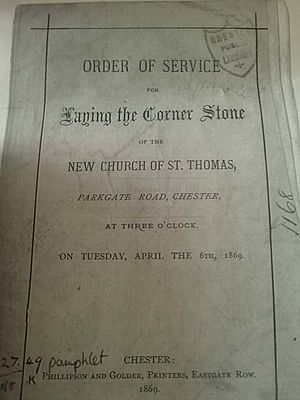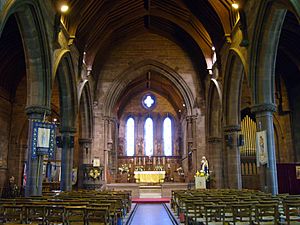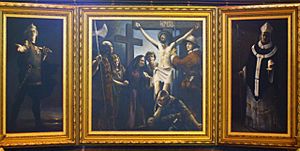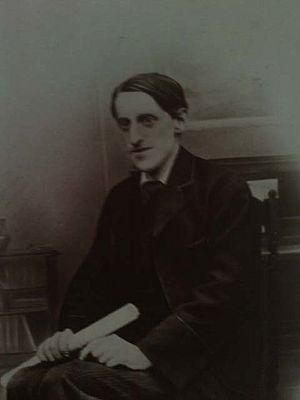St Thomas of Canterbury Church, Chester facts for kids
Quick facts for kids St. Thomas of Canterbury Church, Chester |
|
|---|---|
| Lua error in Module:Location_map at line 420: attempt to index field 'wikibase' (a nil value). | |
| OS grid reference | SJ 402 672 |
| Location | Parkgate Road, Chester, Cheshire |
| Country | England |
| Denomination | Anglican |
| Churchmanship | Anglo-Catholic |
| Membership | 153 |
| Weekly attendance | 72 |
| Website | St Thomas, Chester |
| History | |
| Status | Parish church |
| Dedication | Thomas Becket |
| Consecrated | 1872 |
| Architecture | |
| Functional status | Active |
| Heritage designation | Grade II |
| Designated | 10 January 1972 |
| Architect(s) | George Gilbert Scott John Oldrid Scott |
| Architectural type | Church |
| Style | Gothic Revival |
| Completed | 1881 |
| Specifications | |
| Capacity | 240 |
| Materials | Sandstone, Westmorland Slate, English Oak |
| Administration | |
| Parish | St. Oswald and St. Thomas of Canterbury |
| Deanery | Chester |
| Archdeaconry | Chester |
| Diocese | Chester |
| Province | York |
The Church of St. Thomas of Canterbury is an active Anglican church in the city of Chester, England. It is located in an area known as "The Garden Quarter," close to the University of Chester. The church building was finished in 1872. However, the parish it serves, called St. Oswald, is much older, dating back to around 980 AD.
The church is an important historical building. It is listed as a Grade II listed building on the National Heritage List for England. This means it is a special building that needs to be protected. The church is part of the diocese of Chester.
Contents
A Look at the Church's Past
Why a New Church Was Built
In 1868, the population in the St. Oswald parish was growing. People decided they needed a new, smaller church, called a "chapel of ease." Land was found on Parkgate Road. The first stone was laid on April 6, 1869. The church was built with the idea of making it bigger later.
The new chapel was named St. Thomas of Canterbury. It was officially opened on April 4, 1872. People were allowed to get married there starting in 1877. Services included Holy Communion and daily prayers.
Becoming the Main Parish Church
By 1880, the people of St. Oswald's parish agreed to make St. Thomas's their main parish church. Before this, the south part of Chester Cathedral was used as the parish church. The last service there was on Christmas Day in 1881.
The church was then made larger. This included adding two more sections to the main part of the church. They also planned to build a tower with a clock and bells, but it was never fully finished. New seats, an organ area, and stained glass windows were also added.
The Name: St. Thomas of Canterbury
The church was named St. Thomas because there was an old chapel with the same name nearby. This older chapel, dedicated to Thomas Becket, existed by the year 1200. It was used for church services and as a meeting place. After a long time, it became a private house. Today, a pub called The George & Dragon stands on that spot.
Changes Over the Years
In 1882, some parts of the parish were moved to a different church. This helped manage the growing number of people.
In 1895, a smaller "mission church" called the Good Shepherd was opened. It helped serve people in the western part of the parish. This mission church also housed a school for young children. However, it closed in 1919 and was later completely shut down in the 1960s.
From 1909, the church started following an "Anglo-Catholic" style of worship. This included daily mass and sung services on Sundays. This tradition continues today.
In 1967, St. Oswald's parish joined with another nearby parish, Little St. John. The church of Little St. John stopped being used for services in 1969. In 1972, St. Oswald's parish became part of a larger "Chester Team Parish." This meant many city churches were grouped together.
In 2005, the Chester Team Parish was divided into two new parishes. The church's parish is now called Saint Oswald and Saint Thomas of Canterbury. This name brings back the old patron saint of the parish.
The old house where the vicar (church leader) lived, called the vicarage, was built in 1880. It is now used by the English Department of the University of Chester.
The Church Today
The Church of St. Thomas of Canterbury still follows the Anglo-Catholic traditions it adopted many years ago.
What the Church Aims to Do
The church council has a special statement about its goals:
- Welcome everyone who comes.
- Share God's love with people.
- Teach, baptize, and help people grow in their faith.
- Help people in need with kindness.
- Celebrate through beautiful words, sacraments, and music.
The church also has strong connections with the local school that shares its name.
Services and Events
- Low Mass (a type of church service) is held three times a week.
- A special Choral High Mass is held on Sundays.
- "Exposition of the Blessed Sacrament" happens most Wednesdays.
- An annual Eucharistic Festival is usually held in July.
- The church celebrates its patron saint's day on December 29.
Groups and Activities
St. Thomas's has several groups that help the church and bring people together. Members can join these groups if they wish:
- Sunday School (for children)
- Youth Group
- Young Adults Group
- Choir (for singing)
- Mothers Union
- Association of Christian Fellowship
- Social Group
- Our Lady of Walsingham Cell (a religious group)
- Servers Guild (people who help during services)
How the Church is Built
The church is built from red sandstone and has a slate roof. It is designed in the Gothic Revival style. The church was designed by George Gilbert Scott and is actually not fully finished. For example, the tower has a space for bells but the bell chamber above it and the tall spire were never built. Some of the decorative stone work around the windows and at the top of the main hall (nave) is also incomplete. It is thought that the walls and ceiling were meant to be plastered, but this was also left undone.
The church has a main hall (nave) with five sections. It also has a side aisle on the north and south. The area near the altar, called the chancel, is raised by three steps. There is also a special area called the Lady Chapel at the end of the north aisle, which is also raised.
Special Features of the Church
Beautiful Carvings
The church has two wonderfully carved altarpieces, called reredoses, made by an artist named Deacon. One is in the Lady Chapel (from 1913) and the other is in the main altar area (from 1909).
The Lady Chapel altarpiece shows a Madonna and Child. The Lady Chapel altar itself has three carved pictures: a pelican feeding its babies, a Lamb holding a shepherd's staff, and an Eagle flying. Around the bottom of the altar, it says, "I believe in the Communion of Saints."
The main altarpiece in the sanctuary shows symbols of the Instruments of the Passion. On top of it are four statues of archangels: Michael, Gabriel, Raphael, and Uriel. The wooden main altar has three painted pictures: the Annunciation, the Nativity, and the Visitation.
Windows and Other Details
The large window at the west end of the church was made by Charles Eamer Kempe in 1885. The baptismal font (where baptisms happen) at the west end used to have a beautiful carved cover, but it fell down in 1980. Also at the west end are a Sacristy (a room for sacred items) and a choir vestry (a changing room for the choir).
In the south aisle, there is an altar dedicated to St. Oswald and St. Thomas. It has a special three-part painting (triptych) of these saints.
The clock in the tower was put there in 1913. It was a gift from John and Almeida Latham to celebrate the birth of their daughter, Beatrice Mary. The clock was made by J.B. Joyce and Co.
The church bell has an old inscription on it. This bell was originally in the parish of St. Oswald. It was moved several times before coming to St. Thomas's.
The Church Organ
The church has a modern digital organ that was installed in 1996. Before this, there were other organs. The first organ was built in Chester. It was later rebuilt and then replaced by a different organ in 1984. Parts of the older organs were sometimes used in the newer ones. The organ from 1984 was removed in 2014.
The Church School
A school called the National School was started in Parkgate Road in 1871. This was around the same time the church was being built. The school opened its doors on March 25, 1873. It was for young boys and girls.
During the Second World War, children from Liverpool who had to leave their homes shared the school with local children. Over the years, the school changed. Since 1984, it has been a junior school.
The school closed in July 2011. A new church school, Chester Blue Coat CE Primary School, opened in September 2011 to replace it.
Images for kids






